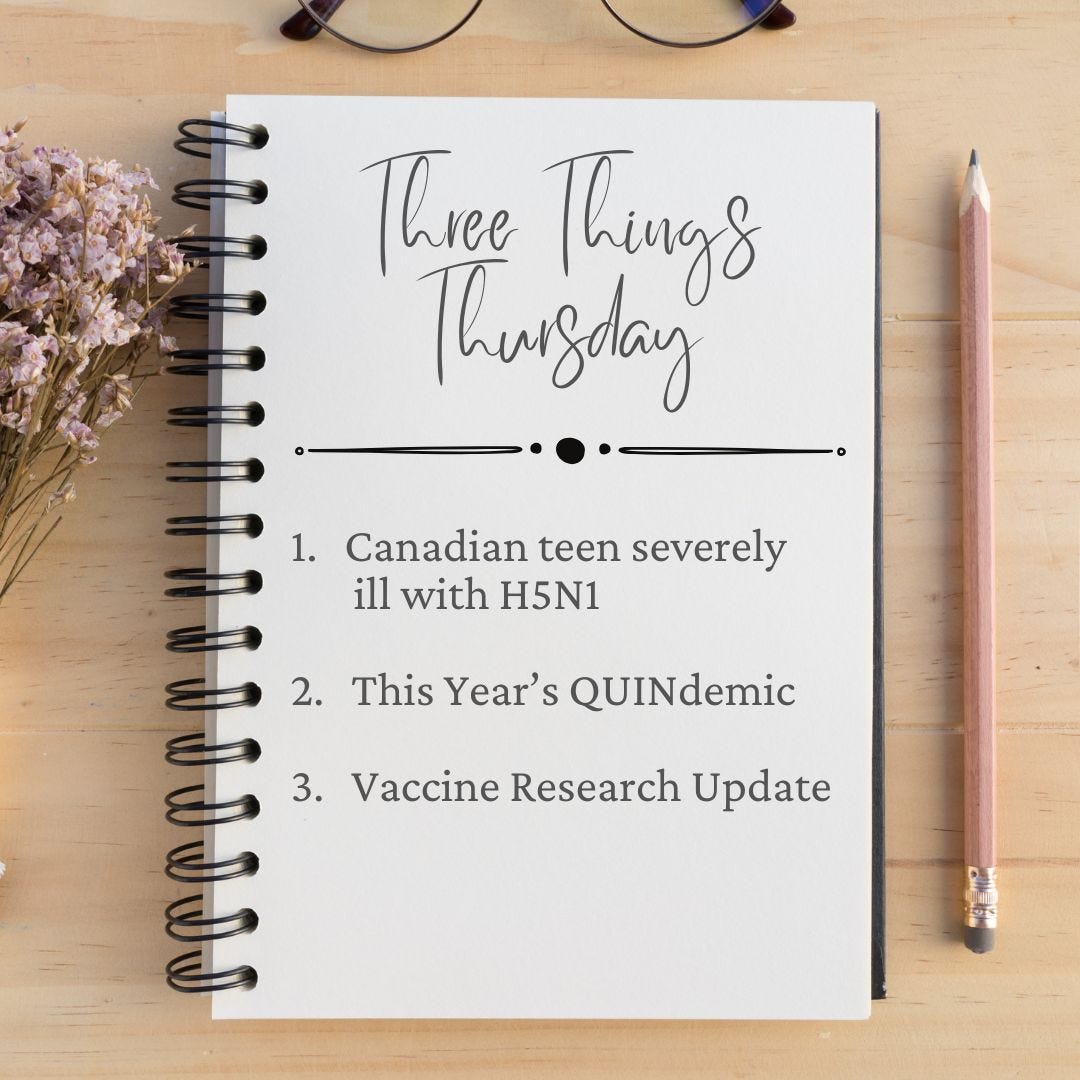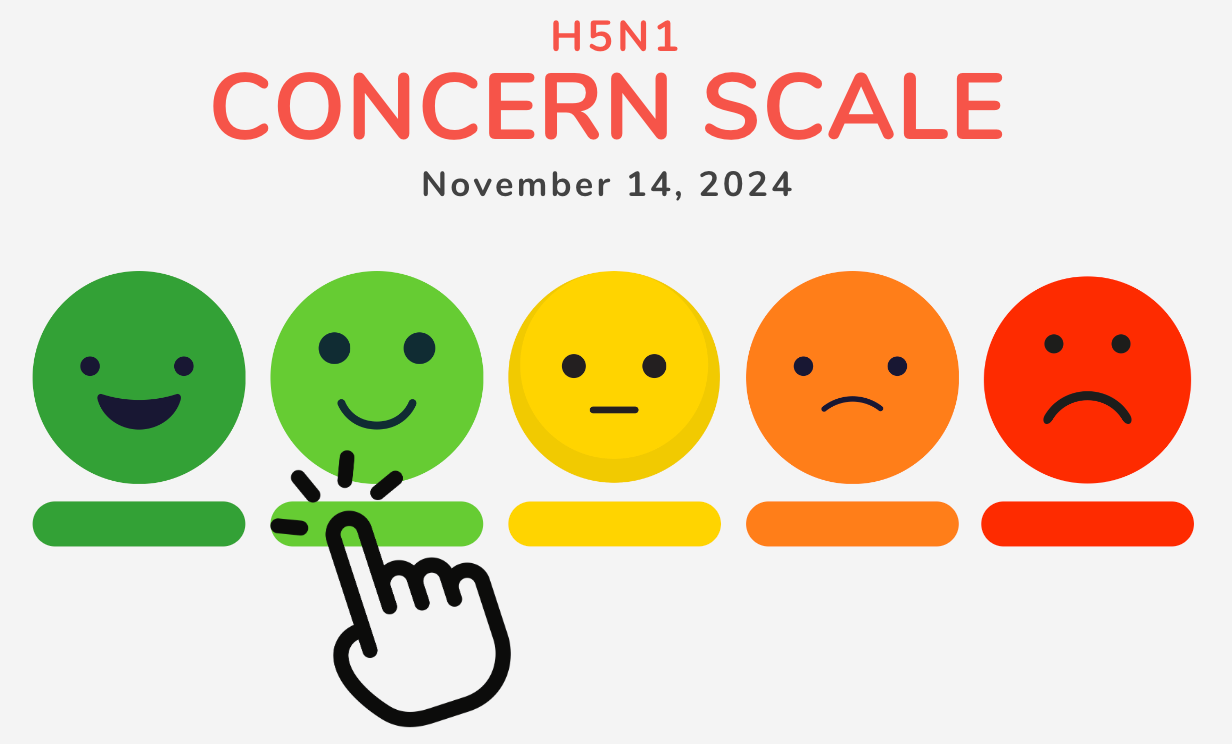Three Things Thursday highlights three things I am paying attention to as an epidemiologist each week. While there are three things below — important public health news from this past week — the big news was announced about an hour ago…
President-elect Trump has selected RJK Jr to lead the Department of Health & Human Services. This is the federal agency that oversees CDC, NIH, Medicare, and Medicaid, among others. As I wrote last week —
“RJK Jr and the leadership role he will likely play in the Trump Administration keeps me awake at night. NO JOKE. A recent article in Forbes summarizes why I am so concerned about RFK Jr becoming a federal health leader —
'He has repeatedly made false claims that vaccines cause autism and chaired the Children's Health Defense, an organization that says it wants to end childhood health crises but is a source of vaccine misinformation. He compared vaccine mandates to the Holocaust in 2022, which he apologized for, and was previously banned by YouTube and Instagram for spreading misinformation about the COVID-19 vaccine.’”
I’ve been waiting (anxiously) all day for the official announcement to be made (I heard through the grapevine that it was coming). And made the conscious decision to hold off on posting my three things until after the announcement because I want to be VERY clear about how I feel about this appointment and what it means for our health.
First, I agree 100% with House Minority Leader Hakeem Jeffries, who told Politico today —
“Is RFK Jr. the best qualified person in the United States of America
to lead us forward as we grapple with an enormous amount of
health challenges in this country? The answer is clearly he is not.”
Second — I am hard a work on a piece all about debunking everything RFK Jr has said about vaccines and autism. I will get it to you soon. Be sure you are subscribed, as the post will include both a detailed review of the science as well as talking points, social media posts, and other resources you can use within your communities.
As I said last week, I am doubling-down on my mission and will work hard and more collaboratively to CREATE HEALTHY COMMUNITIES FOR ALL.
This work officially got harder today.
But I am not going anywhere.
I am committed to ensuring healthy communities for all.
I will use science & data to inform every post, recommendation, policy, and update I make here. Every word/phrase highlighted in purple is a link to a study, resource, or data supporting my thoughts (or providing you access to the original research). Should you have questions — because understanding the research is hard work and is too often misinterpreted — please ask.
And be sure to go back and (re)read my posts on how to read the epidemiological research.
Hoping this post (and all of the others) helps to educate and empower you
to be healthy and create healthy communities.
Here are the three news stories from the week that you should know about…
Canadian Teenager with H5N1 in Critical Condition
On Tuesday, Canadian health authorities confirmed that a teenager from British Columbia, who was previously healthy, was hospitalized and is in critical condition with H5N1. The patient's symptoms — conjunctivitis, fever, and cough — began on November 2. After symptoms worsened, the patient was hospitalized at BC Children's Hospital on November 8. Yesterday the Public Health Agency of Canada (PHAC) announced that the teenager had H5N1.
The strain of H5N1 that the Canadian teenager was diagnosed with is NOT the one circulating in dairy cows. Instead, it is the strain circulating in poultry. To date — there are no other human cases of H5N1 in Canada.
The investigation into how this teenager became infected is now underway…
According to their parents (the teen is too ill to answer questions), the patient has not been around poultry. And all of the pets — cats, dogs, and reptiles — the teen has been in contact with have tested negative for H5N1.
The investigation continues…
Like the case in Missouri, this case of H5N1 with an unknown source of exposure is unsettling to the public health/medical community for a couple of reasons —
Unlike the 46 cases of H5N1 in humans in the US, this case in Canada departs from the pattern of mild illness we’ve seen. The US cases have all been mild disease, with most individuals reporting conjunctivitis (aka pink eye) as their primary symptom. The teenager in Canada is severely ill. This new case raises more questions about the transmission of H5N1 and how sick it can make humans…
The fact that the teenager is suffering from severe illness could be a sign that age is a factor in determining disease severity. Younger individuals have less previous exposure to flu viruses, in general, and may be more susceptible to the severe consequences of an H5N1 infection.
In 2009, the swine flu outbreak (H1N1) began with two unexplained cases of the virus in two children, who had unknown sources of exposure and were not connected to each other. This feels eerily similar — with the Missouri case + the Canadian teen.
That said, Bonnie Henry — British Columbia’s provisional health officer — told STAT News, “Obviously my spidey senses went off when we first heard about this. But I’m more reassured in that we followed up with anybody that they had close contact with during the … infectious period. We’ve not found anybody else who is sick. And we’ve been testing. So I’m more comfortable that it was a single exposure and a more rare event. … More cases would have come to light by now if this was an exposure event that exposed multiple numbers of people, or there had been person-to-person transmission, which we know is rare with H5N1.”
The risk to the public and our collection concern regarding community spread of H5N1 remains low.
However, know that we — the public health community — are watching this situation closely. And we are aware that H5N1 has now been reported in all 50 states (Hawaii confirmed H5N1 in its wastewater on Tuesday).
This Year’s Quindemic
We have officially entered respiratory virus season. And while the number of individuals visiting a healthcare provider because of a respiratory illness remains low, we are starting to see some indications that the number of illnesses is growing across the country. The map below illustrates the acute respiratory illness (ARI) metric. ARI captures a broad range of diagnoses from emergency department visits for respiratory illnesses, from the common cold to infections like influenza, RSV, and COVID-19. As you can see a few states have reach moderate levels of disease spread. We will watch to see how the colors on the map change from week-to-week. Stay tuned…
In years past, we have talked about a triple-demic — flu, COVID, and RSV.
This year, we are facing a quindemic — flu, COVID, RSV, pneumonia, and pertussis.
To prevent the spread of these respiratory diseases —
Stay home when you are sick (and isolate from others in your home).
Cover your nose & mouth when you cough or sneeze.
Wash your hands. After you sneeze into them. Before you eat. Before you prepare food. After you use the restroom.
Get vaccinated. We have vaccines that are safe and effective at preventing (severe) illness from flu, COVID, RSV, and pertussis. Be sure you and your loved ones are vaccinated.
Vaccine Research Update
This week a study was published in the Journal of the American Medical Association (JAMA) that confirmed that it is safe to get your flu and COVID vaccines at the same time. The study — the first randomized, placebo-controlled trial analyzing the side effects of the co-administration of the vaccines in the US — found no difference among people who received the COVID-19 and flu shots simultaneously in different arms and those who got the shots spaced apart by a week or two.
If you haven’t gotten your flu or COVID shot yet this year, do so today (get both!).
Additionally, research published this week in the journal Vaccine found that unvaccinated children are at a much higher risk of developing multisystem inflammatory syndrome in children (MIS-C) if they were unvaccinated with two doses of Pfizer's mRNA COVID vaccine before contracting COVID-19.
The study included all of the MIS-C cases diagnosed in California from January 2, 2021, to June 23, 2022. In the 5- to 11-year-old age-group, 85% of those with MIS-C were unvaccinated, and the incidence rate ratio of MIS-C in unvaccinated children was 3.3 times higher than in fully vaccinated children. Among 12- to 17-year-olds, 90% of those with MIS-C were unvaccinated, and the IRR of MIS-C in unvaccinated children was 22.9 times higher.
"These findings further enforce the importance of vaccinating children against SARS-CoV-2."
It’s been a doozy of a week. If you have questions, thoughts, comments, or suggestions, please reach out —
And it has NEVER been more important for you to share this post with your friends and family. We are going to have to build community and work together to build healthy communities over the next four years. We ALL need to be on the same page.
Epi(demiology) Matters is written by Dr. Becky Dawson, PhD MPH — an epidemiologist, teacher, mom, wife, and dedicated yogi. She is a tenured professor at Allegheny College, Research Director at a community hospital, and an exclusive contributor (all things health & medicine) at Erie News Now (NBC/CBS). Her goal is to create healthy communities for all. She writes Epi Matters — first & foremost because epidemiology does matter (to all of us) and she hopes that each post will help to educate and empower readers to be healthy and create healthy communities.
Be sure you and your friends and family are subscribed so you don’t miss a post —
Epi(demiology) Matters is free — because science, reports, news, updates, and alerts about health should NOT be behind a paywall. EVER. Everyone needs access to up-to-date health information in order to be healthy and create healthy communities for all.








Thank you, Becky. RFK Jr. is such a frightening appointment. Let’s hope it does not pass muster in Congress.
Thank you for providing FACTS. It is a frightening time when people do not believe in science and actual RESEARCH.